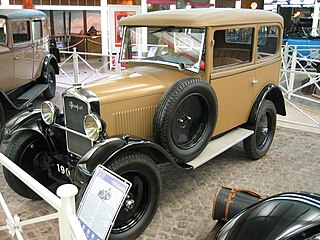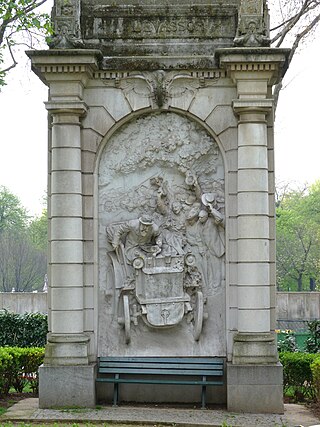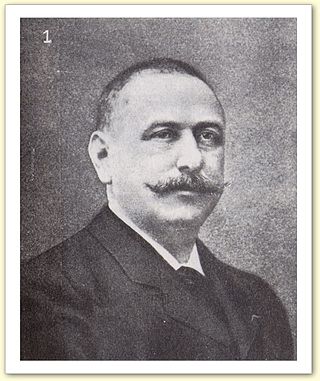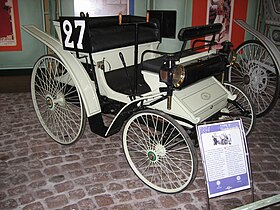
Peugeot is a French brand of automobiles owned by Stellantis. The family business that preceded the current Peugeot companies was founded in 1810, and it is regarded as the oldest car company in the world. On 20 November 1858, Émile Peugeot applied for the lion trademark. Armand Peugeot (1849–1915) built the company's first car steam tricycle. They joined forces with Léon Serpollet in 1886; this was followed in 1890 by an internal combustion car with a Panhard-Daimler engine.
Grand Prix motor racing, a form of motorsport competition, has its roots in organised automobile racing that began in France as early as 1894. It quickly evolved from simple road races from one town to the next, to endurance tests for car and driver. Innovation and the drive of competition soon saw speeds exceeding 100 miles per hour (160 km/h), but because early races took place on open roads, accidents occurred frequently, resulting in deaths both of drivers and of spectators. A common abbreviation used for Grand Prix racing is "GP" or "GP racing".

Panhard was a French motor vehicle manufacturer that began as one of the first makers of automobiles. It was a manufacturer of light tactical and military vehicles. Its final incarnation, now owned by Renault Trucks Defense, was formed by the acquisition of Panhard by Auverland in 2005, and then by Renault in 2012. In 2018 Renault Trucks Defense, ACMAT and Panhard combined under a single brand, Arquus.

The Benz Velo was one of the first cars, introduced by Carl Benz in 1894 as the followup to the Patent Motorwagen. 67 Benz Velos were built in 1894 and 134 in 1895. The early Velo had a 1L 1.5-metric-horsepower engine, and later a 3-metric-horsepower engine giving a top speed of 19 km/h (12 mph). The Velo was officially introduced by Karl Benz as the Velocipede, and became the world's first standardized serial production car. The Velocipede remained in production between 1894 and 1902, with a final count of over 1,200 produced.

The Peugeot Type 190 S is a model of Peugeot produced between 1928 and 1931.

The Paris–Bordeaux–Paris Trail race of June 1895 is sometimes called the "first motor race", although it did not fit modern competition where the fastest is the winner. It was a win for Émile Levassor, who came first after completing the 1,178km race in 48 hours, almost six hours before second place. However, the official winner was Paul Koechlin, who finished third in his Peugeot, exactly 11 hours slower than Levassor, but the official race regulations had been established for four-seater cars, while Levassor and runner-up Louis Rigoulot were driving two-seater cars.

Émile Constant Levassor was a French engineer and a pioneer of the automobile industry and car racing in France.

Pierre Giffard was a French journalist, a pioneer of modern political reporting, a newspaper publisher and a prolific sports organiser. In 1892, he was appointed Chevalier (Knight) of the Légion d'Honneur and in 1900 he was appointed an Officier (Officer) of the Légion d'Honneur.

The Peugeot Type 175 was a fairly large sports car from Peugeot produced in 1923 and 1924. This model was produced at the factory in Audincourt. The OHV engine, of the LA5 range, displaced 3.0 L and has a 4 speed gearbox. It was only available with the "torpedo sport" or "torpedo grand sport" body at the price of 38,000 old Francs. Colours offered were blue, grey, green or red, with black wings and chassis. The body was made of a wooden frame with steel; the bonnet was made of aluminium with a sloping, nickel-plated window. Blériot headlights and a 12V SEV magneto and starter were fitted. In 1924, H. Petit won the 3-litre category of the 1100 km Paris-Nice race in this model: The "Paris Nice" Peugeot 175 Torpedo Grand Sport

Gustave Adolphe Clément, known from 1909 Clément-Bayard, was a French entrepreneur. Despite being orphaned, he became a blacksmith and a Compagnon du Tour de France. He later ventured into racing and manufacturing bicycles, pneumatic tyres, motorcycles, automobiles, aeroplanes and airships.

Albert Lemaître, , was a French sporting motorist and early racing driver. He was the first petrol powered finisher in what is described as 'the world's first competitive motoring event' when he drove his Peugeot Type 7 from Paris to Rouen at 19 km/h (12 mph) in 1894. The Comte de Dion had finished first but his steam-powered vehicle was ineligible for the main prize which was shared between the manufacturers Peugeot and Panhard.

Paris–Rouen, Le Petit Journal Horseless Carriages Contest, was a pioneering city-to-city motoring competition in 1894 which is sometimes described as the world's first competitive motor race.

The Peugeot Type 7 was built on the same chassis as the Peugeot Type 6 and shared some mechanicals but its engine was twice the size, and twice as powerful. It had a phaeton style body for 4 persons. 25 units were built between 1894 and 1897. The engine was carried over to the Type 8.
The Paris–Marseille–Paris race was the first competitive 'city to city' motor race originating in Paris, where the first car across the line was the winner, prior events having selected the winner by various forms of classification and judging. The race was won by Émile Mayade who completed the ten-day, 1,710 km, event over unsurfaced roads in 67 hours driving a Panhard et Levassor.

Émile Louis Mayade was a French motoring pioneer and racing driver. He drove a Panhard et Levassor in the world's first 'city to city' motoring contest from Paris to Rouen in 1894 and went on win the world's first open motor race, the 1896 Paris–Marseille–Paris, where the first driver across the line was the winner.

Auguste Frédéric Doriot was a French motoring pioneer who developed, built and raced cars for Peugeot before founding his own manufacturing company D.F.P. in combination with Ludovic Flandrin and the Parant brothers. In 1891, Doriot and his Peugeot colleague Louis Rigoulot completed the longest trip by a petrol powered vehicle when their self-designed and built Daimler powered Peugeot Type 3 completed 2,100 kilometres from Valentigney to Paris and Brest and back again. They were attached to the first Paris-Brest-Paris bicycle race, but the duo reached Brest one day after the winning cyclist, Charles Terront, finished in Paris, and they then finished six days after him.
Auto racing began in the mid-19th century. It became an organized sport in the early 20th century and has grown in popularity ever since.
Albert Marie Louis Delagarde (1898–1990) was an engineer and automotive designer known primarily for his work with French carmaker Panhard & Levassor.
Louis Bionier (1898–1973) was a French automotive engineer. He is best known as head of chassis development and chief stylist for carbuilder Panhard. He was also involved in the design of some of Panhard's military vehicles.














